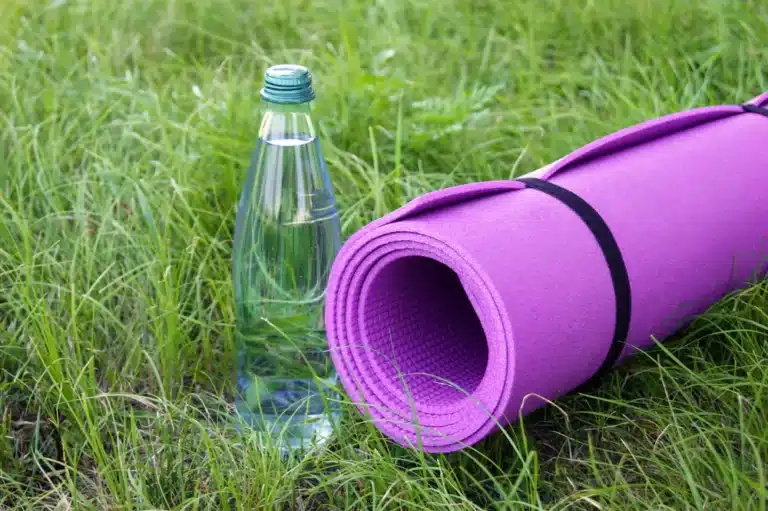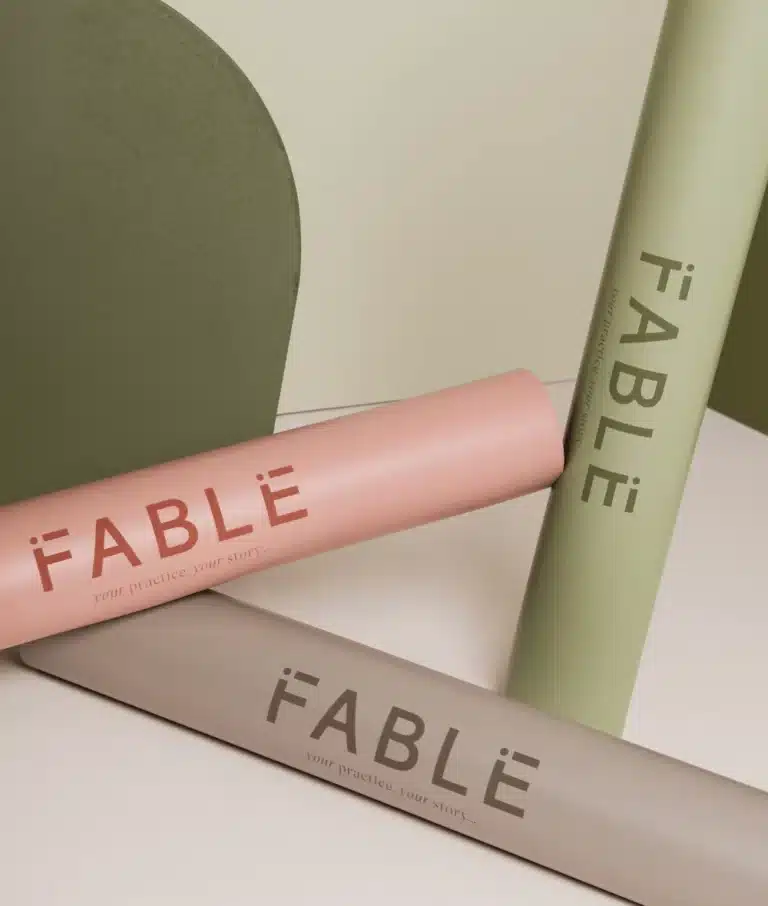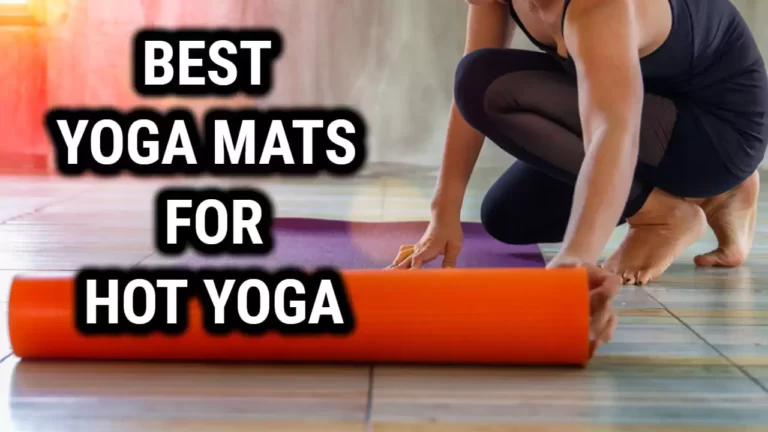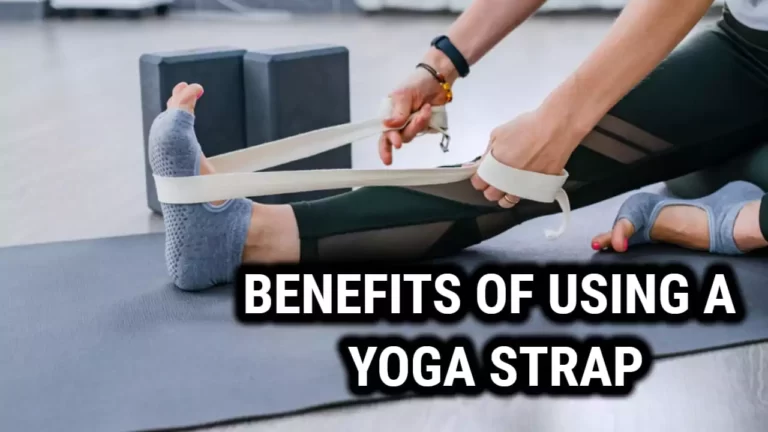Finding Comfort and Support: The Best Yoga Mats for Bad Knees

Are you looking for the perfect yoga mat for your bad knees?
Yoga can be an excellent way to improve physical and mental health, but if you have bad knees it is important to find the right mat.
You need a yoga mat that is thick enough to provide cushioning and support, non-slip so it won’t move around, and long enough to fit your body and all of the poses you want to do.
With the right mat, you can enjoy practicing yoga safely and comfortably.
Read on for some tips on what factors to consider when choosing a yoga mat for your bad knees as well as helpful advice on how best to practice with them.
Key Takeaways
- A thick yoga mat with at least 1/4′ thickness provides cushioning and support for bad knees.
- Rubber or cork materials offer extra grip and stability for knee support.
- Foam mats designed for knee problems offer additional padding and shock absorption.
- Using props and modifications can provide extra support and relieve pressure on the knees during yoga practice.
The importance of finding the right yoga mat for individuals with bad knees
If you’re dealing with bad knees, finding the right yoga mat is essential – it’ll make your practice more comfortable and enjoyable!
When selecting a yoga mat for bad knees, consider thickness. A thick yoga mat can help relieve knee pain and provide extra cushioning.
The best yoga mats are usually made from ecofriendly materials like foam or cork. Jels Extra Thick Yoga Mat is an excellent choice as it offers superior cushioning and support for bad knees. It’s lightweight yet firm enough to provide stability during your practice.
Plus, the non-slip surface will ensure that you don’t slip or fall while doing poses.
In conclusion, having the right yoga mat for bad knees is essential for a safe and comfortable practice – so choose carefully!
Factors to Consider When Choosing a Yoga Mat for Bad Knees
When it comes to choosing a yoga mat for bad knees, there are several factors to consider. Firstly, the thickness of the mat is essential for providing ample support and cushioning to your knee joints.
Secondly, look for mats made from materials such as rubber or cork which provide extra grip and stability when performing poses.
Thirdly, texture also plays an important role in comfort level; look for mats that have subtle raised ridges or patterns to ensure secure footing.
Additionally, if you need additional cushioning due to existing knee injuries then opt for thicker mats with more padding.
Finally, having a good grip on your mat is essential when practicing yoga poses so choose ones that feature a textured surface designed specifically for extra traction.
Thickness: How thick should a yoga mat be for knee support?
For bad knees, a yoga mat should be thick enough to provide extra cushioning and support. A good yoga mat for those with knee pain should be at least 1/4′ thick. It should also have an extra-thick layer or a built-in knee pad. Additionally, it should offer firm support yet cushion the joints when kneeling.
A thicker mat with more cushioning will help relieve pressure on your knees and reduce discomfort during poses that require kneeling or squatting. The right thickness of a yoga mat is essential for those with bad knees as it can make all the difference in how comfortable you are while practicing poses that require weight-bearing on your knees.
Material: What are the best materials for a yoga mat for bad knees?
Choosing the right material for your yoga practice is essential if you have bad knees. A good yoga mat should be thick enough to provide ample cushioning and prevent strain on your joints.
The best yoga mats for bad knees are usually made from materials that are both durable and comfortable, such as polyurethane foam or cork. Additionally, a yoga knee pad can offer extra support for the knees while providing additional cushioning.
The Gaiam Essentials Thick Yoga Mat is especially popular because of its thick cushioned design, which helps alleviate pressure on the joints and provides great grip power for better balance and stability during poses.
For those looking for an eco-friendly option, the Manduka Eko Yoga Mat is made from natural tree rubber and offers excellent grip power while also being extra thick for maximum comfort.
Texture: How does the texture of a yoga mat affect knee comfort?
The texture of your yoga mat can make a huge difference when it comes to knee comfort. For those with sensitive knees, the best yoga mat should be as soft and cushioned as possible. A textured surface isn’t necessary for a good grip, but can add additional cushioning on pressure points like the knees. Certain materials have natural textures that provide extra cushioning during practice, while other mats may need an added layer or towel to improve knee comfort.
| Material | Texture |
|---|---|
| PVC | Smooth Surface |
| Jute/Hemp | Rough Texture |
| Cork | Grippy Texture |
PVC yoga mats are known for their smooth surfaces and lightweight feel, but they often lack cushioning around the knees. Jute or hemp mats offer much more structure than PVC, along with a rough texture which provides additional support and padding for sensitive areas like the knees. Cork is another popular material used in yoga mats because its grippy texture helps keep you in place during poses – plus it’s very supportive for joints like the knees. Ultimately, selecting a Yoga mat tailored to your needs will help you get the most out of every practice session no matter what type of pose you do!
Cushioning: What type of cushioning is suitable for individuals with knee problems?
If you suffer from knee problems, finding the right cushioning can make a world of difference in your practice. When looking for a yoga mat for bad knees, consider a thick cushioned yoga mat with extra cushioning to help relieve pressure on your joints.
A yoga knee pad cushion is also beneficial as it helps to support and protect your knees while practicing. Additionally, special foam mats are designed specifically for those suffering from knee problems that feature extra padding and shock absorption.
This will keep you comfortable and supported throughout your practice so you can focus on improving without worrying about pain or injury.
Grip: Why is a good grip essential for knee stability during yoga practice?
Having a secure grip when practicing yoga is essential for knee stability and can help protect you from injury. A good grip on your yoga mat provides traction, allowing your joints to move freely without slipping or sliding. It also keeps your knees in alignment with the rest of your body, which helps to prevent strain or discomfort.
An anti-slip surface on your mat will reduce the risk of slips and falls. A textured surface can provide extra cushioning for sensitive knees. Non-skid materials allow for greater flexibility during practice. Grippy mats help keep your knees in place as you transition between poses, reducing stress on the joints.
Having a good grip on your yoga mat ensures that each pose is done with proper form and allows you to focus solely on the practice instead of worrying about injuries due to lack of support or control.
Tips for Practicing Yoga with Bad Knees
If you have bad knees, yoga can be a great way to help with knee pain relief. Before beginning any practice, it’s important to warm up your body and joints properly.
Consider starting your practice with gentle stretches and strengthening exercises that specifically target the knees, as well as modifications and props which will support your knees during poses like warrior II or downward facing dog.
Proper alignment and posture can go a long way in preventing strain on the knee joint.
Lastly, always listen to your body – if something doesn’t feel right or feels too intense, don’t push beyond your limits!
Warm-up exercises to prepare the knees for yoga practice
Before engaging in a yoga practice, it’s important to warm up your knees with simple exercises that will help them feel ready for the journey ahead.
Begin by standing on your yoga mat and taking a few deep breaths. Gently move your joints by rotating both of your ankles in circles. Do this for about 30 seconds and then move onto flexing and extending each knee joint.
After completing these movements, try kneeling on the mat with both legs bent at 90 degrees. Hold this position for around 10 seconds before slowly rising back to a standing position.
Finally, take some time to stretch out your hip joints while still focusing on keeping your knees relaxed throughout the entire process. Taking these few moments to warm up can make all the difference when practicing yoga with bad knees!
Modification and use of props to support the knees during poses
Navigating poses with sore knees doesn’t have to be a struggle – use props and modifications to ensure your practice is comfortable!
A knee pad cushion or thick mat can help reduce pressure on your joints while doing yoga.
You can also modify certain poses, like downward-facing dog, by placing blankets under the knees for extra support.
To find the best yoga knee pads, look for ones that offer cushioning without compromising stability.
Keep in mind that when using props, you should adjust them accordingly as needed.
With proper modifications and props, you can practice yoga safely and comfortably even with sore knees.
Proper alignment and posture to prevent knee strain
Maintaining proper alignment and posture during your practice is key to avoiding knee strain. It’s important to ensure that your joints are properly supported, while also maintaining the correct form for each yoga pose. Here are some tips to keep in mind:
- Adjust Your Practice: Don’t push yourself too hard if you have sore knees – modify poses as needed or take a break if necessary. A thick yoga mat for bad knees can help provide extra cushioning and support.
- Focus On Alignment: Pay close attention to the alignment of your body during each pose, both at the beginning and end of the movement. Make sure that your hips, shoulders, and head are all in line with each other.
By following these guidelines, you can make sure that every yoga class is an enjoyable experience for your body!
Gentle stretches and knee-strengthening exercises for knee pain relief
To help relieve your knee pain, try gentle stretches and exercises that strengthen the muscles around your knees. An exercise mat is essential for protecting your joints and providing support while exercising. Look for a perfect yoga mat with extra cushioning to protect your knees and provide stability when stretching. A premium yoga mat can also be helpful in supporting you during more intense exercises as it provides superior grip and durability.
Make sure to listen to your body and adjust the intensity of each exercise according to how you feel. Go slow, stretch carefully, and use proper alignment to ensure your safety while performing these exercises.
The importance of listening to your body and not pushing beyond limitations
It’s vital to pay attention to your body and not overdo it when it comes to stretches and exercises for knee pain relief. When using a yoga mat for bad knees, make sure you don’t push yourself too hard; there’s a risk of further injury if the poses are done incorrectly or with too much intensity.
Listen carefully to what your body’s telling you and stop if you feel uncomfortable. Don’t forget that any kind of knee injury needs time to heal, so take it slowly and be mindful of your movements. Even though some poses may be beneficial for knee pain relief, they shouldn’t ever be painful; if they’re causing discomfort, then lessen the intensity or avoid them entirely.
A good quality yoga mat comes in handy as it provides extra cushioning and support for your knees, making sure that no unnecessary pressure’s being applied.
Remember: always listen to your body before attempting any type of stretches or exercises specifically targeting knee pain!
Conclusion
Finding the right yoga mat for bad knees can make all the difference when it comes to practicing yoga safely and comfortably. Consider factors like cushioning, grip, non-slip material, and length when selecting a mat that works for you.
With the right tools in place, you’ll be sure to get the most out of your practice while keeping your knees happy and healthy. So don’t let bad knees stand in the way of enjoying all that yoga has to offer!
FAQ’s
Q: What is the best yoga mat for bad knees?
A: The best yoga mat for bad knees is one that provides extra cushioning and support. Look for an extra thick yoga mat or a mat that specifically mentions it is suitable for sensitive knees.
Q: Are there any specific brands that offer good yoga mats for bad knees?
A: Yes, some popular brands that offer good yoga mats for bad knees include Gaiam Essentials Thick Yoga Mat, JELS Extra Thick Yoga Mat, and Manduka Eko Yoga Mat.
Q: Why do I need a yoga mat if I have bad knees?
A: Using a yoga mat can provide additional comfort and cushioning for your knees and joints during your yoga session. It can help reduce the discomfort and strain on your knees and make your practice more enjoyable.
Q: What should I look for in a yoga mat for bad knees?
A: When choosing a yoga mat for bad knees, look for features like extra thickness, cushioning, and support. It’s also important to ensure that the mat is non-slip and provides enough grip to prevent any accidental slips or injuries.
Q: Are there any specific materials that are recommended for yoga mats for bad knees?
A: Eco-friendly yoga mats made from natural rubber or other soft and supportive materials can be a good choice for people with bad knees. These mats often provide better cushioning and are more gentle on your joints.
Q: Can using a yoga knee pad help with knee discomfort during yoga practice?
A: Yes, using a yoga knee pad can provide an extra layer of cushioning and support specifically for your knees. It can help alleviate knee discomfort and reduce the pressure on your joints.
Q: Will an extra thick yoga mat be more suitable for bad knees?
A: Yes, an extra thick yoga mat, typically around 6mm or more, can offer better shock absorption and cushioning for your knees. It can provide additional support and comfort, especially if you have bad knees.
Q: What are the benefits of using a proper yoga mat for bad knees?
A: Using a proper yoga mat for bad knees can help reduce the risk of injury and strain on your joints. It can provide better stability, support, and cushioning, allowing you to practice yoga comfortably and safely.
Q: Can a yoga mat also be used for other exercises besides yoga?
A: Yes, a yoga mat can be a versatile mat that can be used for various exercises and activities. It can provide cushioning and support for exercises like pilates, stretching, meditation, and floor workouts.
Q: What are the top 5 yoga mats for bad knees?
A: The top 5 yoga mats for bad knees are Gaiam Essentials Thick Yoga Mat, JELS Extra Thick Yoga Mat, Manduka Eko Yoga Mat, Pro Yoga Mat, and a knee pad cushion such as the Yoga Knee Pad Cushion.






